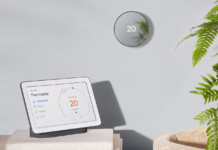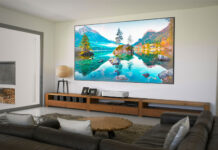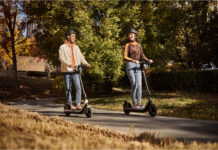 Baby gates are great safety devices for baby-proofing your home. They can help prevent accidental falls, and ensure your little one doesn’t enter rooms she’s not supposed to, and interact with things that could harm her, or that she could break. Once your little one is up and ready to roam, whether it’s on her hands and legs, butt, or a wobbly two feet, you’d be surprised at how far she can get in a short period of time. A baby gate can provide tremendous peace-of-mind, especially at home, but even, in some cases, while traveling or visiting a friend.
Baby gates are great safety devices for baby-proofing your home. They can help prevent accidental falls, and ensure your little one doesn’t enter rooms she’s not supposed to, and interact with things that could harm her, or that she could break. Once your little one is up and ready to roam, whether it’s on her hands and legs, butt, or a wobbly two feet, you’d be surprised at how far she can get in a short period of time. A baby gate can provide tremendous peace-of-mind, especially at home, but even, in some cases, while traveling or visiting a friend.
Why baby gates?
As much as we’d love to do so, it’s impossible to keep our eyes on our kids every second of every day. And it only takes a second for a little one to roam into the kitchen and pull something off the counter, or crawl out of her crib in the middle of the night and head right for the stairs. Once your child starts walking, a baby gate can keep her confined to safe spaces, and, more importantly, out of others that present danger.
Which type of baby gate is right?
You might think that baby gates are a one-size-fits-all product. They aren’t. There are actually several types that differ based on where you might want to place them, the size of the opening, if they’re meant for use out of home, and even what finish makes sense for you. And it’s important to choose the right one.
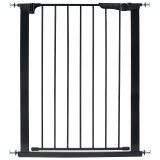 Types of baby gates
Types of baby gates
Pressure-mounted baby gates
These pressure-mounted baby gates secure to doorway or hallway area without the use of tools, but rather by fitting into an opening using tension against both sides of the walls or doorway. They’re great for positioning at the doorway of a room, for example, but not really meant for use by stairways. You’ll want to use these kinds of baby gates for high traffic areas, where you might be opening and closing them quite often. They might also be the preferred options for rented condos or apartments, where you’d rather not (or might not be permitted to) drill holes in the walls. The KidCo Pressure Mount Extra Tall and Wide Auto Close Gateway Safety Gate is, as the name implies, extra wide and tall so it can fit in large openings. And it uses Magnet-Lock technology that will automatically close the gate and lock it every time, plus a Hold button if you want it to stay open for an extended period. Imagine, for example, if the gate is positioned between the kitchen and living room, where you might often be bringing snacks and drinks, and making numerous trips back and forth while your hands are full.
 Hardware mounted baby gates
Hardware mounted baby gates
These gates fit between doorways or walls, and require screws and installation, drilling into the frame or studs behind the wall, and attaching via brackets. They are a must for installation at the top of stairs because they can prevent kids from toppling over them; though they can be used anywhere. The Munchkin Extending Hardware Mounted Wood Safety Gate has a neat tilting hinge mechanism that will avoid damage to your walls, and it can be easily removed when you aren’t using it. The wooden gate can be positioned to open in one or both directions, though if you’re setting a gate up at the top of stairs, have it open away from the stairs instead of toward them: safety first!
Expandable baby gates
These are great if you plan to use the gates in different areas of the home, or while 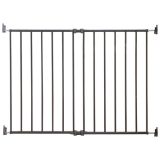 traveling. They can fit various-sized entryways and are often easy to install, without the use of any tools. The aforementioned The KidCo Pressure Mount Extra Tall and Wide Auto Close Gateway Safety Gate is not only tall at 36”, but it can be used with six optional extensions to accommodate larger openings that are up to four feet wide. This could be ideal for homes with open concept living areas, where there’s no distinct separation between the living room and kitchen, for example.
traveling. They can fit various-sized entryways and are often easy to install, without the use of any tools. The aforementioned The KidCo Pressure Mount Extra Tall and Wide Auto Close Gateway Safety Gate is not only tall at 36”, but it can be used with six optional extensions to accommodate larger openings that are up to four feet wide. This could be ideal for homes with open concept living areas, where there’s no distinct separation between the living room and kitchen, for example.
Wide baby gates
Many baby gates are made specifically to fit extra-wide openings or can adjust and expand in order to accommodate them. The Qdos Extending SafeGate Hardware Mounted Safety Gate in slate expands to fit openings from 27” to 41” wide, and can be set up on an up to 180-degree angle to accommodate uneven openings or baseboards, which you might often find in older homes.
Freestanding baby gates
 Effectively functioning as playpens, freestanding baby gates have walls of their own, enveloping your little one in a secure square or hexagonal play area with a childproof, walk-through door while providing you a clear view in and them a clear view out. Many of them, like the Bily Freestanding Wood Superyard, can open up to function more like a gate, blocking wider areas and doorways – ideal if you need a temporary solution, such as keeping your little one secure while new furniture is being moved into the house. Or, maybe you’re just getting some quick paperwork done at the table beside them and are OK with them roaming around the basement, but want to make sure they don’t venture out to the laundry room. Freestanding baby gates can be great for travel as well, since they fold up easily, and can be conveniently put away when you aren’t using them.
Effectively functioning as playpens, freestanding baby gates have walls of their own, enveloping your little one in a secure square or hexagonal play area with a childproof, walk-through door while providing you a clear view in and them a clear view out. Many of them, like the Bily Freestanding Wood Superyard, can open up to function more like a gate, blocking wider areas and doorways – ideal if you need a temporary solution, such as keeping your little one secure while new furniture is being moved into the house. Or, maybe you’re just getting some quick paperwork done at the table beside them and are OK with them roaming around the basement, but want to make sure they don’t venture out to the laundry room. Freestanding baby gates can be great for travel as well, since they fold up easily, and can be conveniently put away when you aren’t using them.
Accessories for baby gates
There are lots of accessories to choose from for safety gates, whether it’s to accommodate more complex installations or a change in the position of the gate. For example, the Qdos Universal Stair Mounting Kit for Hardware and Pressure Mounted Safety Gates can be used with both hardware- and pressure-mounted gates, aiding in mounting them to square banisters or round spindles. Many freestanding baby gates also work with separately-purchased panel extensions so you can 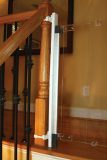 use them in larger areas, or simply make the play area bigger, if desired.
use them in larger areas, or simply make the play area bigger, if desired.
What to consider when selecting a baby gate
Where you want to place the baby gate
Before selecting a baby gate, it’s important to determine where you want to place it. If you want to use it at the top of stairs, it’s important to choose a hardware-mounted option. If you’re placing it in a doorway, hallway, or between two rooms, either pressure-mounted or hardware-mounted will do. Consider, also, if you want the placement to be permanent, or if you might be moving the gates from room to room often enough that quick and easy removal is important. (Though if you do plan to move it often, it might be worthwhile to consider buying multiple gates.)
Measure, measure, measure the space for the baby gate
While many baby gates extend to fit different width openings, you should always measure the space to ensure the one you want will fit properly or that you purchase the necessary extension kits to make it do so. If you have an extra-wide opening, or your child is tall for 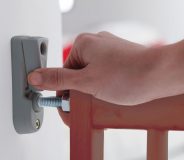 his age, look for models that will accommodate. And by the way, don’t forget to consider height as well: you don’t want your child to be able to climb over the baby gate, so look for one that’s at least ¾ of your child’s height.
his age, look for models that will accommodate. And by the way, don’t forget to consider height as well: you don’t want your child to be able to climb over the baby gate, so look for one that’s at least ¾ of your child’s height.
Check the latches on the baby gate
Is your child particularly clever when it comes to unlocking certain types of latches? Check how the gate latches to ensure you’re comfortable that it won’t be easy for him to open, but simple enough for an adult to do it one-handed. Also, if the gate will be positioned in a high-traffic area, or in a spot where you’re often with your hands full (e.g. by the basement stairs where you’re constantly bringing laundry up and down) consider a model with an auto-close feature so you don’t have to worry about manually locking it each time you move in and out. These can also be lifesavers if you have older kids that are likely to forget to lock the gate when they open it. This way, you don’t need to constantly worry that big bro or sis didn’t lock the gate.
Do you want to use the baby gate outside of the house?
If your child is often over at grandma and grandpa’s place, you travel often, or head up to the cottage in the summer, you might want to consider a travel-friendly, temporary gate that can easily fold up and be positioned in another home when needed. In these cases, a freestanding option might make the most sense.
Design of the baby gate
Sure, a baby gate is there for a purpose, not as part of your home’s decor. But that doesn’t 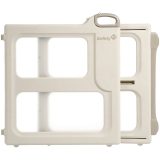 mean that it can’t look good. No one wants to spend tons of money on beautiful furniture and decor for the home only to plop a gaudy-looking baby gate in the middle of main floor! Consider the finish and style of the gate, particularly if you have multiple kids (and maybe another on the way!) and plan to have the gate set up for some time to come. Consider the colour and style—a baby gate you choose to place at the doorway of your child’s play area in the basement or his bedroom might look completely different from the one you’d place at the bottom of the stairs in your main living area.
mean that it can’t look good. No one wants to spend tons of money on beautiful furniture and decor for the home only to plop a gaudy-looking baby gate in the middle of main floor! Consider the finish and style of the gate, particularly if you have multiple kids (and maybe another on the way!) and plan to have the gate set up for some time to come. Consider the colour and style—a baby gate you choose to place at the doorway of your child’s play area in the basement or his bedroom might look completely different from the one you’d place at the bottom of the stairs in your main living area.
Construction of the baby gate
Naturally, you’ll want to examine durability to ensure a baby gate can withstand knocks, bumps, and rough swings from your child. When it comes to construction, baby gates come in all flavours, including metal, plastic, and wood. If it has slats, make sure they are no more than 3” apart to avoid your child’s head getting stuck in between them.
Materials used in the baby gate
All-metal gates like the Qdos Extending SafeGate Hardware Mounted Safety Gate can withstand daily wear and tear; but you might prefer plastic, like with the Safety 1st Perfect Fit Dual-Mode Hardware/Pressure Mounted Security Safety Gate because of the easily-wipeable clear panel and non-marring bumpers that protect woodwork and walls. Also consider the colour and material: some baby gates are transparent or mesh so 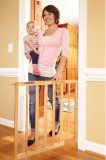 you can see through to the other side, while others may be a solid colour that blocks your view as well. If the gate is going to be a permanent fixture in the home for some time to come, consider one that will fit nicely with the decor of your child’s nursery if it’s outside of his door, staircase, or particularly if it’s going to be situated in your main living area. Wooden gates like the Qdos Spectrum Hardware Mounted Safety Gate are arguably the most attractive options. This one comes in mahogany and is made from strong-engineered plywood. Another option is non-toxic rubberwood, as in found in the Storkcraft Easy Walk-Through Safety Gate, which comes in a natural finish to blend into a variety of home decors.
you can see through to the other side, while others may be a solid colour that blocks your view as well. If the gate is going to be a permanent fixture in the home for some time to come, consider one that will fit nicely with the decor of your child’s nursery if it’s outside of his door, staircase, or particularly if it’s going to be situated in your main living area. Wooden gates like the Qdos Spectrum Hardware Mounted Safety Gate are arguably the most attractive options. This one comes in mahogany and is made from strong-engineered plywood. Another option is non-toxic rubberwood, as in found in the Storkcraft Easy Walk-Through Safety Gate, which comes in a natural finish to blend into a variety of home decors.
Baby-proof your home with a baby gate
Ready to outfit the home for your toddlers, babies, or upcoming little ones? Best Buy offers a wide selection of baby gates in a variety of types, finishes and sizes to fit in doorways, hallways, and at staircases, to meet your baby safety needs. Make your home a safe place for baby to play, grow, and enjoy.

